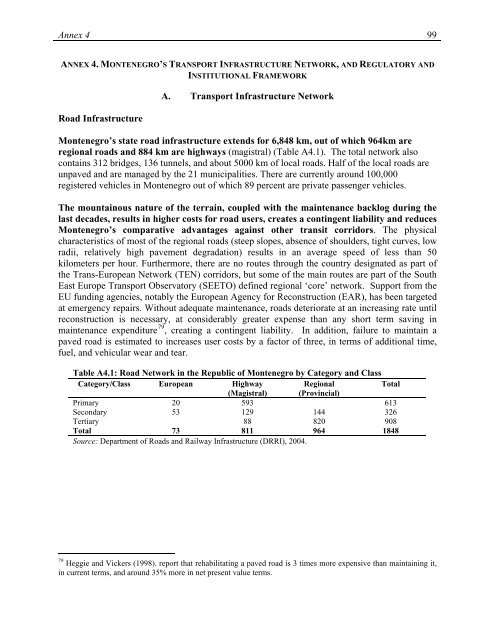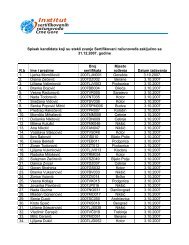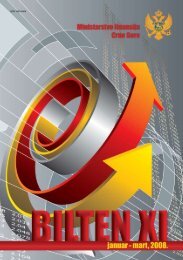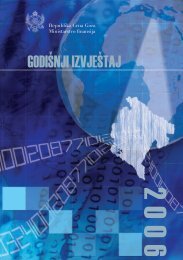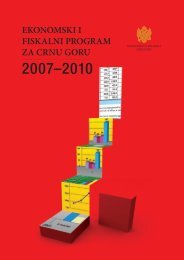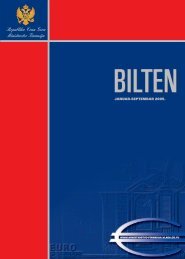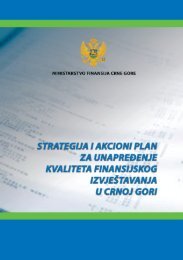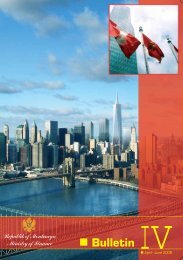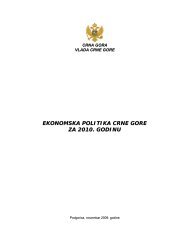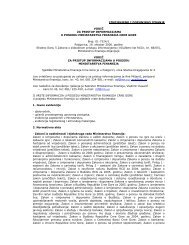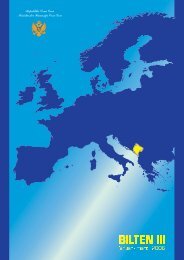Republic of Montenegro: Public Expenditure and ... - Vlada Crne Gore
Republic of Montenegro: Public Expenditure and ... - Vlada Crne Gore
Republic of Montenegro: Public Expenditure and ... - Vlada Crne Gore
You also want an ePaper? Increase the reach of your titles
YUMPU automatically turns print PDFs into web optimized ePapers that Google loves.
Annex 4 99<br />
ANNEX 4. MONTENEGRO’S TRANSPORT INFRASTRUCTURE NETWORK, AND REGULATORY AND<br />
Road Infrastructure<br />
INSTITUTIONAL FRAMEWORK<br />
A. Transport Infrastructure Network<br />
<strong>Montenegro</strong>’s state road infrastructure extends for 6,848 km, out <strong>of</strong> which 964km are<br />
regional roads <strong>and</strong> 884 km are highways (magistral) (Table A4.1). The total network also<br />
contains 312 bridges, 136 tunnels, <strong>and</strong> about 5000 km <strong>of</strong> local roads. Half <strong>of</strong> the local roads are<br />
unpaved <strong>and</strong> are managed by the 21 municipalities. There are currently around 100,000<br />
registered vehicles in <strong>Montenegro</strong> out <strong>of</strong> which 89 percent are private passenger vehicles.<br />
The mountainous nature <strong>of</strong> the terrain, coupled with the maintenance backlog during the<br />
last decades, results in higher costs for road users, creates a contingent liability <strong>and</strong> reduces<br />
<strong>Montenegro</strong>’s comparative advantages against other transit corridors. The physical<br />
characteristics <strong>of</strong> most <strong>of</strong> the regional roads (steep slopes, absence <strong>of</strong> shoulders, tight curves, low<br />
radii, relatively high pavement degradation) results in an average speed <strong>of</strong> less than 50<br />
kilometers per hour. Furthermore, there are no routes through the country designated as part <strong>of</strong><br />
the Trans-European Network (TEN) corridors, but some <strong>of</strong> the main routes are part <strong>of</strong> the South<br />
East Europe Transport Observatory (SEETO) defined regional ‘core’ network. Support from the<br />
EU funding agencies, notably the European Agency for Reconstruction (EAR), has been targeted<br />
at emergency repairs. Without adequate maintenance, roads deteriorate at an increasing rate until<br />
reconstruction is necessary, at considerably greater expense than any short term saving in<br />
maintenance expenditure 79 , creating a contingent liability. In addition, failure to maintain a<br />
paved road is estimated to increases user costs by a factor <strong>of</strong> three, in terms <strong>of</strong> additional time,<br />
fuel, <strong>and</strong> vehicular wear <strong>and</strong> tear.<br />
Table A4.1: Road Network in the <strong>Republic</strong> <strong>of</strong> <strong>Montenegro</strong> by Category <strong>and</strong> Class<br />
Category/Class European Highway<br />
Regional<br />
Total<br />
(Magistral) (Provincial)<br />
Primary 20 593 613<br />
Secondary 53 129 144 326<br />
Tertiary 88 820 908<br />
Total 73 811 964 1848<br />
Source: Department <strong>of</strong> Roads <strong>and</strong> Railway Infrastructure (DRRI), 2004.<br />
79 Heggie <strong>and</strong> Vickers (1998). report that rehabilitating a paved road is 3 times more expensive than maintaining it,<br />
in current terms, <strong>and</strong> around 35% more in net present value terms.


